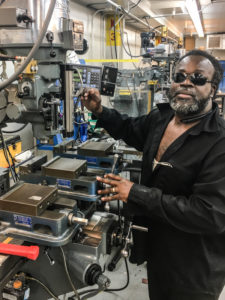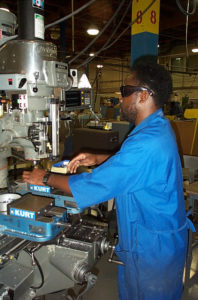Roosevelt Stevenson
Unstoppable
By Suzanne Yeagley

In 1989, Roosevelt Stevenson lost his sight. He had just turned 22 years old when he was shot and beaten in Michigan. In addition to going blind, Roosevelt lost the ability to talk, he lost his hearing, and he couldn’t recognize anyone outside of his immediate family. Eventually, his hearing returned, and with lots of help, he learned how to speak again.
Roosevelt says, “It took years and years to get my voice back, to be able to string words together into sentences. I was able to communicate, but I wasn’t able to hold a decent conversation. My whole vocabulary went blank. I had to fight to put a word in the space where it belonged.” About that time in his life, Roosevelt adds, “The choices you make are going to follow you for the rest of your life. I could’ve made a different choice. I had to learn everything over, and everything was harder the second time around.”
But Roosevelt is hard-working and determined. He and his wife left Michigan and moved to Washington in 1994, where they learned sign language. He first worked at Orion Industries, where he was trained on how to use aerospace machinery. He loved operating the machinery, and in 1996, he started at the Lighthouse. Roosevelt was eager to learn and right away started working on the aerospace manufacturing machines at the Lighthouse, setting up table saws, bridge ports, edgers, drills, and other equipment.
One of the things Roosevelt enjoyed demonstrating at the Lighthouse was the difference between a person with sight running a machine and a person who is blind running the same machine with speech output. The person who is blind can run the machine nearly as fast—within seconds of the same time—as the person with sight.

Roosevelt attributes much of his success to the community at the Lighthouse, and as he gained experience, he passed on his knowledge by using his skills to train others. For more than ten years, he trained new hire Lighthouse employees, along with those who were DeafBlind. “The Lighthouse was a blessing to me,” he says, adding that before he worked there, “I didn’t know anything about computers.”
At the Lighthouse, Roosevelt has been given opportunities to take communication classes and learn to be a trainer. In the process of learning about computers and technology, he also learned more about accommodations available for him.
“Being employed with the Lighthouse has allowed me the opportunity to socialize myself with many in the disabled community, and to become a great go-to person for many people. I also experienced new opportunities, such as being named The National Peter J. Salmon Award Winner and Employee of the Year. I participated in blind man derby races where I actually had the opportunity to drive and race derby cars on a track. This is one of the many fun activities we participated in.”
He continues, “I built great leadership skills by being an active member of the safety committee, organizing and planning annual employee gatherings, and encouraging other visually-impaired peers to get involved and have a voice, while not forgetting to have fun. In my spare time I volunteered to do motivational speaking to youth.”
In 2014, Roosevelt started a beep baseball team, The Tacoma Tide, one of many teams that are part of the National Beep Baseball Association. If you’re not familiar with the sport, it’s a six-inning game where the pitcher, catcher, and one or two outfielders are sighted, but the rest of the players are visually impaired. All non-sighted players must wear blindfolds. When the ball is hit, one of the two bases, which are four-foot-tall cylinders, emits a continuous buzzing sound, and the batter must get to the base before the defensive player fields the ball.
After many years on the West Coast working for the Lighthouse at both Seattle and Joint Base Lewis-McChord locations, Roosevelt recently relocated to the Lighthouse’s newest manufacturing facility in Summerville, South Carolina where he assembles the nuts and screws that are used on an airplane to bolt the floor in the belly of the plane, among other things. The move has taken him closer to his family in Mississippi, and he can now visit them more easily than he could in the past.
Roosevelt has been married to his wife for 25 years, and he has twin 18-year-old daughters, a 16-year-old son, and two dogs. When he’s not helping others at the Lighthouse, he’s spending his time with friends and family, playing dominoes, and driving around with his son in his 1983 Oldsmobile with the T-Top open.